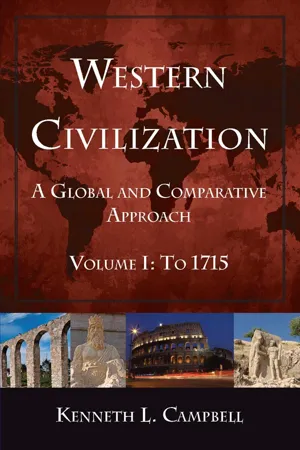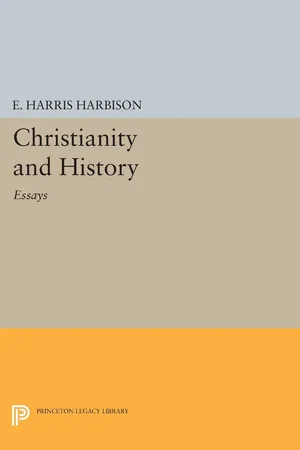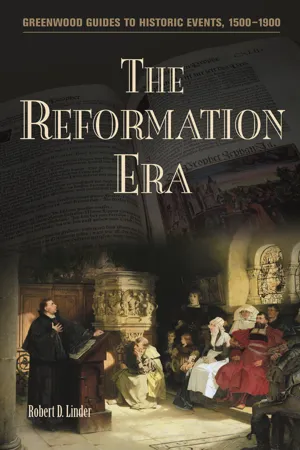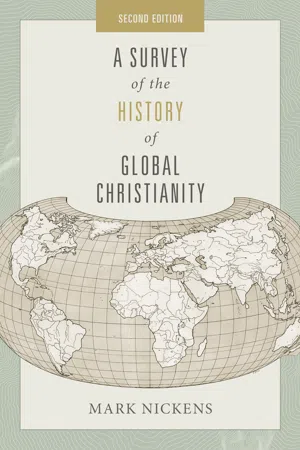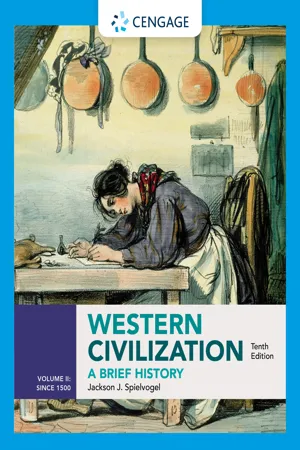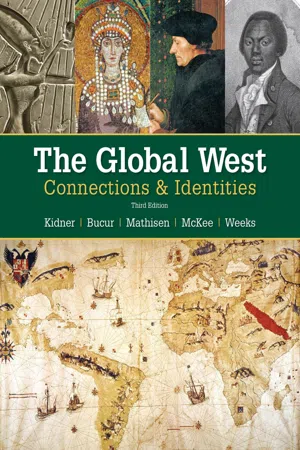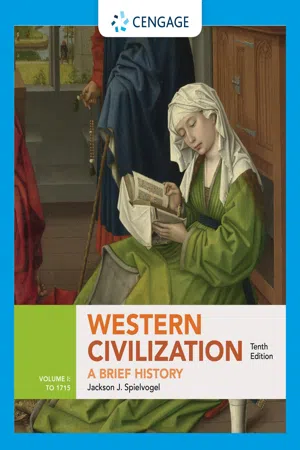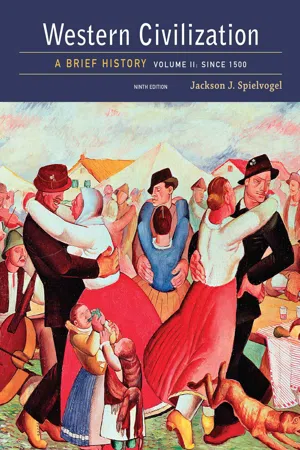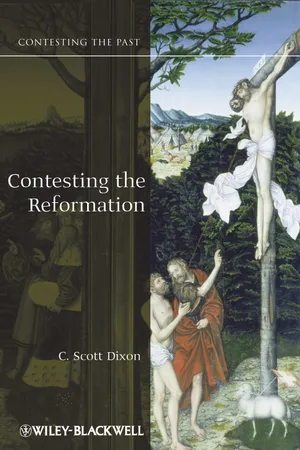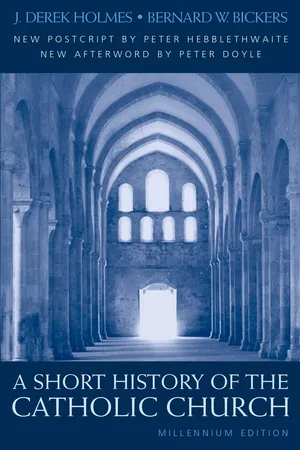History
The Reformation in Europe
The Reformation in Europe was a 16th-century religious and political movement that led to the creation of Protestantism. It was sparked by Martin Luther's criticism of the Catholic Church's practices and beliefs, leading to widespread religious and social upheaval across Europe. The Reformation resulted in the division of Western Christianity into Catholicism and various Protestant denominations.
Written by Perlego with AI-assistance
Related key terms
1 of 5
12 Key excerpts on "The Reformation in Europe"
- eBook - ePub
Western Civilization: A Global and Comparative Approach
Volume I: To 1715
- Kenneth L. Campbell(Author)
- 2014(Publication Date)
- Routledge(Publisher)
Not all Old Believers were superstitious fanatics blindly adhering to past traditions. They continued to provide an alternative approach to spirituality than that offered by the dominant clerical and political elite. Conclusion The religious reformation that began in Europe in the sixteenth century can be considered one of the most significant events that shaped world religious history. The Reformation was a series of movements that differed significantly from each other, but, when taken together, resulted in the sudden and rapid polarization of the monolithic Christian church into two distinct groups–the Roman Catholic and the Protestant. But Protestant and Catholic political leaders shared some important commonalities. For all their differences, Protestants and Catholics still worshipped the same God, regarded the Bible as their primary religious source, held the same conception of fallen humanity contaminated by original sin and needing the intercession of Christ as redeemer, and believed in the competing forces of good and evil in the world. These beliefs manifested themselves in the sixteenth and seventeenth centuries in the European-wide persecution of people believed to be witches in league with the devil (see Chapter 4 in Volume II). Both Catholics and Protestants relied heavily on logic and rational argument to defend their positions, regarding God as a being whose existence could be proved and demonstrated. Many Catholics and Protestants believed that two religions could not coexist within the same state, although in practice Catholics and Protestants in a number of local communities across Europe found a way to do just that. Both Catholic and Protestant rulers regarded religious uniformity as a prerequisite for political loyalty. Both persecuted religious minorities and feared countries with a different religion as real or potential enemies - eBook - ePub
Historical Theology
An Introduction to the History of Christian Thought
- Alister E. McGrath(Author)
- 2012(Publication Date)
- Wiley-Blackwell(Publisher)
The Reformation initially led to the formation of a cluster of Protestant churches in Europe, subsequently to the renewal and reformation of the Catholic church in the same region, and inevitably to conflict between Protestants and Catholics on the one hand, and between the various Protestant churches on the other. For historians, the importance of this period lies in the social and political ramifications of the Reformations, the birth of confessional Europe, the political and intellectual consolidation of both the Protestant and Catholic Reformations, the so-called radical Reformation, the intensification of religious, social, and sexual discipline on the part of secular and ecclesiastical authorities, and the origins of the Wars of Religion. Yet the period is of pivotal importance to the development of modern Christian theology, as will become clear in this chapter. A particularly significant development which took place during the later part of this period is the expansion of western Christianity from its European context. The arrival of English Puritan communities in Massachusetts Bay and Spanish and Portuguese missionaries in South America opened the way to a further period of expansion of Christianity, which would become of increasing theological significance during the modern period.Reformation – or Reformations?
The term “Reformation” is traditionally used by historians and theologians to refer to the western European movement, centering upon individuals such as Martin Luther, Huldrych Zwingli, and John Calvin, concerned with the moral, theological, and institutional reform of the Christian church in that region. More recent scholarship, noting the emergence of reforming movements throughout Europe at this time, has rightly suggested that we should speak of “reformations.” The use of the plural form ensures that the significance of the mainline Protestant Reformation is safeguarded, while at the same time recognizing that this same era gave birth to the Catholic Reformation, the radical Reformation, and the movement now generally known as the “Second Reformation.”Initially, up to about 1525, the Reformation may be regarded as revolving around Martin Luther and the University of Wittenberg, in modern-day northeastern Germany. However, the movement also gained strength, independently at first, in the Swiss city of Zurich in the early 1520s. Through a number of complex developments, the Zurich Reformation gradually underwent a series of political and theological modifications, eventually coming to be associated primarily with the city of Geneva (now part of modern-day Switzerland, although then an independent city-state) and John Calvin. - eBook - PDF
Christianity and History
Essays
- Elmore Harris Harbison(Author)
- 2015(Publication Date)
- Princeton University Press(Publisher)
II C H R I S T I A N I T Y IN H I S T O R Y : T H E P R O T E S T A N T R E F O R M A T I O N 7 · T H E P R O T E S T A N T R E F O R M A T I O N * T HE PROTESTANT Reformation was a vastly complex religious upheaval within Western Christendom which began in 1517 with Martin Luther's protest against the abuse of indulgences. It reached the climax of its creative and destructive power in European society within the next century and a half. Now after four centuries the force of this revolutionary movement is largely spent, but Protes- tants can never entirely forget that they are heirs of a revo- lutionary tradition. It is well to be humble about any attempt to understand such a movement. Like a river, placid on the surface, but fed by countless unseen springs and rivulets, the Reforma- tion is a simple historical movement only to those who are content to look at the surface and ignore the myriad cross- currents beneath. Too many Protestants today, for in- stance, think of the Reformation as simply a revolt of in- telligent and long-suffering people against obvious and intolerable "abuses" in the Roman Church, on the analogy of their grammar-school picture of the American Revolu- tion. "The movements of the human spirit, its sudden flashes, its expansions and its pauses, must ever remain a mystery to our eyes, since we can but know this or that of the forces at work in it, never all of them together." So a very great historian, Leopold von Ranke, wrote a hundred years ago of the Reformation—and we know of some com- plications today of which even he was ignorant. * In 1957, a friend of mine on the faculty of Princeton Theological Seminary, Hugh Thomson Kerr, Jr., had the task of lining up visiting lecturers for a course primarily for church-school teachers on the history of the Church. He asked if I thought I could sum up my thought about the Reformation in about 5,000 words. - eBook - PDF
- Robert D. Linder(Author)
- 2007(Publication Date)
- Greenwood(Publisher)
Another new term used in place of ‘‘Protestant’’ is ‘‘Reformation churches.’’ Even the term ‘‘origins of the Reformation’’ has been called into question by some revisionist historians because it suggests that a reformation was bound to occur, and this, in turn, can lead to studying the Late Middle Ages largely to uncover factors that make the Reformation inevitable. Since nothing in history is ‘‘inevitable,’’ and since standard usages of the past often still serve well the needs of the present, this work will take such matters as recent challenges to standard terminology into consideration without violating the can- ons of common sense. In any event, the Reformation resulted in a lasting division in a Church that, at least in Western Europe, had retained its essential unity for more than a thousand years. This fact alone makes this era of immense importance. Moreover, the legal existence of more than one Christian Church was difficult to accept after a millennium of religious unity, and this fact was only reluctantly acknowledged when it became evident that neither dialogue nor suppression could restore the Church’s unity. Religious divisions, as well as political, economic, and social factors, led to military conflict that vexed Europe between 1550 and 1648. At a local level, parishes, villages, guilds, and families also experienced strife as religious disagreement 3 The Road to Reformation forced many of those who made spiritual choices in this period to seek a new life elsewhere. This produced the great migratory trek to other places that still continues for many people of European descent even today. Further, these terrible conflicts helped over the long term to undermine some of the most positive aspects of the reform move- ments and eventually lessened rather than increased the impact of Christianity upon society. The Medieval Background To paraphrase William Inge, the twentieth-century Dean of Lon- don’s St. - eBook - PDF
- C. Scott Dixon(Author)
- 2008(Publication Date)
- Wiley-Blackwell(Publisher)
The Reformation, in this view, can only be understood in its relation to the social, cultural and political forces of the age. Even Protestant historians, inspired by Ranke and legiti-mized by archival evidence, began to turn their backs on estab-lished interpretations. In his History of Dogma (1886) Adolf von Harnack related Luther’s ideas to centuries of Christian thought and ended by criticizing the reformer for being unfair to some central Catholic ideas. Still more revisionist was the work of Ernst Troeltsch, like Harnack a Protestant scholar, who extended his critique to the movement as a whole. In con-trast to the many scholars who thought of the Reformation as the point of division between the medieval and the modern age, 188 Reformation Histories Troeltsch held that the movement should be understood as a continuation of medieval culture, for the century of Reform, no less than the age which preceded it, tied Church to State, de-valued the secular world and delayed the arrival of modernity in its search for religious truth. Of course, not all Protestants agreed with Troeltsch, and indeed one corollary of this revi-sionism was a return to, and a confirmation of, the themes that had long been at the heart of Reformation scholarship. Karl Holl, professor of theology at Berlin, was perhaps the most influential voice in this ‘Luther Renaissance’, a scholarly cam-paign to reassess Luther’s theological legacy in the context of its age (Wohlfeil, 1982, pp. 52–6). But by the age of Holl there was too much depth and variety in Reformation scholarship to return to the previous narratives. No greater evidence of the transformation exists than the rediscovery of the radical tradi-tion. Thinkers throughout Europe and North America began to reassess the place of the radical Reformation in the traditional histories. - Mark Nickens(Author)
- 2020(Publication Date)
- B&H Academic(Publisher)
Section 3 Pre-Reformers, the Protestant Reformation, and European Christianity: 1500–1900The beginning of the sixteenth century held much hope for the Roman Catholic Church. Erasmus (discussed in chapter 5 ) wrote to the pope in April 1517, “If ever there was a golden age, then there is good hope that ours will be one.”1 The papacy had seemingly rebounded from its self-inflicted wound of multiple popes reigning at the same time, was confident enough to begin lavishly refurbishing St. Peter’s Basilica in Rome, and looked with hope to the future, not realizing that the bright light shining at the end of the tunnel was actually Martin Luther holding a torch. Instead of a bright future for the Roman Catholic Church, multiple pieces were in place for widespread changes to occur.- Johann Gutenberg developed the printing press in the mid-1400s.
- Pre-Reformers John Wycliffe and Jan Hus had pointed out numerous problems with Roman Catholic Church doctrines.
- The Roman Catholic Church caused two self-inflicted wounds when it elected multiple popes at the same time. First, this produced doubt in the minds of Catholics as to the stability of the leadership structure. Second, the councils resulting from this situation indicated that popes did not have the last word in spiritual matters but could be successfully challenged.
- Muslims began to encroach on the eastern European front. This threat drove the emperor’s attention away from church matters in Europe long enough for Martin Luther to establish his new faith.
- The Renaissance (or Renaissance humanism) produced an emphasis on individual achievement and importance, rejecting centuries of focusing on the maintenance of organizations as the center of society. For example, this led to the concept that one individual could withstand and reject the weight of establishments, churches, or even the Roman Catholic Church (as was the case of Luther).
- eBook - PDF
Western Civilization
A Brief History, Volume II since 1500
- Jackson Spielvogel(Author)
- 2019(Publication Date)
- Cengage Learning EMEA(Publisher)
290 Chapter Outline and Focus Questions 13-1 Prelude to Reformation Q What were the chief ideas of the Christian humanists, and how did they differ from the ideas of the Protestant reformers? 13-2 Martin Luther and the Reformation in Germany Q What were Martin Luther’s main disagreements with the Roman Catholic Church, and what political, economic, and social conditions help explain why the movement he began spread so quickly across Europe? 13-3 The Spread of the Protestant Reformation Q What were the main tenets of Lutheranism, Zwinglianism, Anabaptism, and Calvinism, and how did they differ from each other and from Catholicism? What impact did political, economic, and social conditions have on the development of these four reform movements? 13-4 The Social Impact of the Protestant Reformation Q What impact did the Protestant Reformation have on society in the sixteenth century? 13-5 The Catholic Reformation Q What measures did the Roman Catholic Church take to reform itself and to combat Protestantism in the sixteenth century? 13-6 Politics and the Wars of Religion in the Sixteenth Century Q What role did politics, economic and social conditions, and religion play in the European wars of the sixteenth century? ON APRIL 18, 1521, a lowly monk stood before the emperor and princes of the Holy Roman Empire in the city of Worms. He had been called before this august gathering to answer charges of heresy, charges that could threaten his very life. The monk was confronted with a pile of his books and asked if he wished to defend them all or reject a part. - eBook - PDF
- Frank Kidner, Maria Bucur, Ralph Mathisen, Sally McKee(Authors)
- 2018(Publication Date)
- Cengage Learning EMEA(Publisher)
All Rights Reserved. May not be copied, scanned, or duplicated, in whole or in part. Due to electronic rights, some third party content may be suppressed from the eBook and/or eChapter(s). Editorial review has deemed that any suppressed content does not materially affect the overall learning experience. Cengage Learning reserves the right to remove additional content at any time if subsequent rights restrictions require it. 375 I n the sixteenth century a church renewal move-ment swept over Europe, led by people like the Dominican Girolamo Savonarola (jeer-oh-LAH-mo SAH-von-oh-ROLL-ah) whose portrait is shown at the beginning of this chapter. Church reform had been a fea-ture of Christian life throughout the Middle Ages, but the movement that gained strength around the year 1500 was unparalleled in intensity and scope. It also split the Catholic Church apart. One branch of reform, known as Protestant-ism, rejected the authority of the pope, who until then had been the head of western Christianity. The other branch remained loyal to the pope while insisting on the need for basic change within the Catholic Church. Only the Ortho-dox churches of eastern Europe and the Middle East were largely untouched by these reforms. In Germany, Martin Luther launched Protestant reform. He was followed by other Protestants who began reforms of their own that sometimes disagreed with Luther’s. Thus, Protestants had to choose which reformer to follow. The leaders in Catholic reform were the religious orders of the church and the Roman popes. Together they refashioned Catholicism in ways that lasted until the mid-twentieth century. Because Catholics could rally around the person of the pope, they remained more united than the Protestants, although they, too, experienced division and controversy. As reform touched more and more people’s lives, both Protestants and Catholics had to rethink what it meant to be a Christian. - eBook - PDF
Western Civilization
A Brief History, Volume I: to 1715
- Jackson Spielvogel(Author)
- 2019(Publication Date)
- Cengage Learning EMEA(Publisher)
290 Chapter Outline and Focus Questions 13-1 Prelude to Reformation Q What were the chief ideas of the Christian humanists, and how did they differ from the ideas of the Protestant reformers? 13-2 Martin Luther and the Reformation in Germany Q What were Martin Luther’s main disagreements with the Roman Catholic Church, and what political, economic, and social conditions help explain why the movement he began spread so quickly across Europe? 13-3 The Spread of the Protestant Reformation Q What were the main tenets of Lutheranism, Zwinglianism, Anabaptism, and Calvinism, and how did they differ from each other and from Catholicism? What impact did political, economic, and social conditions have on the development of these four reform movements? 13-4 The Social Impact of the Protestant Reformation Q What impact did the Protestant Reformation have on society in the sixteenth century? 13-5 The Catholic Reformation Q What measures did the Roman Catholic Church take to reform itself and to combat Protestantism in the sixteenth century? 13-6 Politics and the Wars of Religion in the Sixteenth Century Q What role did politics, economic and social conditions, and religion play in the European wars of the sixteenth century? ON APRIL 18, 1521 , a lowly monk stood before the emperor and princes of the Holy Roman Empire in the city of Worms. He had been called before this august gathering to answer charges of heresy, charges that could threaten his very life. The monk was confronted with a pile of his books and asked if he wished to defend them all or reject a part. - eBook - PDF
Western Civilization
A Brief History, Volume II: Since 1500
- Jackson Spielvogel(Author)
- 2016(Publication Date)
- Cengage Learning EMEA(Publisher)
C H A P T E R 13 Reformation and Religious Warfare in the Sixteenth Century CHAPTER OUTLINE AND FOCUS QUESTIONS Prelude to Reformation Q What were the chief ideas of the Christian humanists, and how did they differ from the ideas of the Protestant reformers? Martin Luther and the Reformation in Germany Q What were Martin Luther’s main disagreements with the Roman Catholic Church, and what political, economic, and social conditions help explain why the movement he began spread so quickly across Europe? The Spread of the Protestant Reformation Q What were the main tenets of Lutheranism, Zwinglianism, Anabaptism, and Calvinism, and how did they differ from each other and from Catholicism? What impact did political, economic, and social conditions have on the development of these four reform movements? The Social Impact of the Protestant Reformation Q What impact did the Protestant Reformation have on society in the sixteenth century? The Catholic Reformation Q What measures did the Roman Catholic Church take to reform itself and to combat Protestantism in the sixteenth century? Politics and the Wars of Religion in the Sixteenth Century Q What role did politics, economic and social conditions, and religion play in the European wars of the sixteenth century? CRITICAL THINKING Q Where and how did the reform movements take hold, and how did the emergence of these reform movements affect the political and social realms where they were adopted? CONNECTIONS TO TODAY Q How are the religious controversies of the sixteenth century related to religious and social conditions in the Western world today? A nineteenth-century engraving showing Luther before the Diet of Worms bpk, Berlin/Art Resource, NY 301 Copyright 2017 Cengage Learning. All Rights Reserved. May not be copied, scanned, or duplicated, in whole or in part. Due to electronic rights, some third party content may be suppressed from the eBook and/or eChapter(s). - eBook - ePub
- C. Scott Dixon(Author)
- 2012(Publication Date)
- Wiley-Blackwell(Publisher)
In modern studies, however, there has been a shift away from a focus on Luther to broader questions of context, the result being that more recent historiography tends to analyze how the Reformation sat in relation to the cultural and material conditions of the time. The grand narratives of Ranke and the explanatory theories of Weber and Troeltsch have largely been abandoned, or at least critically intermitted, and replaced by a more source-based, contextualized study of the movement that pays attention to the unique social, political, and cultural aspects of the German lands. 58 With reference to origins, for instance, greater stress is now placed upon the cultural preconditions that facilitated the rise of the movement, including the importance of print culture, the anticlericalism of the medieval age, the growing sense of national identity, and the intellectual climate on the eve of reform. In a similar manner, the debates relating to the great variety of political settings of the rise of the Reformation – the tripartite division of commune, city, and territory – have revealed the complexity of the social and political environments and the consequent need to examine the dynamics at the local levels in order to understand impact. Overarching theories still exist, of course, perhaps the best example in recent years being the paradigm of confessionalization, but scholarship in general has become more specialized and inclined to situate the problematic in specific contexts. 59 But the essential framework for understanding the Reformation remains the German lands. As Moeller himself has suggested, in its essentials the Reformation was a German event before it became a European phenomenon. 60 Scholarship in the Netherlands approaches the Reformation differently, due primarily to the nature of the history it relates - eBook - PDF
- J. Derek Holmes, Bernard Bickers(Authors)
- 2001(Publication Date)
- Burns & Oates(Publisher)
Even when there was a real oppor-tunity of achieving some success against the Turks in the 1470s all the Western leaders employed delaying tactics and any advantage that could have been gained was thereby forfeited. The Protestant Reformation and Catholic Reform 119 In Italy the popes were more successful. Indeed the major factor which allowed them to disregard demands for a council was the strength they enjoyed within the papal states. In 1454 the Peace of Lodi had recognised five main principalities in Italy: Milan, Florence, Venice, the Papal States, and Naples which since 1435 had been reunited with Sicily. Much papal time and energy was spent in power politics in order to maintain this delicate balance in the face of aggression from larger nations, notably France. However, many people outside Italy began to resent this concentration of effort in the political sphere and there was a growing suspicion that the popes themselves were beginning to gauge success or failure in terms of their own political achievements. The popes were also preoccupied with the movement known as the 'Renaissance', although it was not until the nineteenth cen-tury that the term itself became popularly used. The Italian word 'rinascuta' simply means rebirth and contemporaries used it especi-ally when referring to the rebirth of the styles of ancient Rome and Greece in the spheres of literature and art. It was also used by some in a much wider sense covering developments in politics, economics and society at large. Indeed the Renaissance period is often regarded as a link period between the medieval and the modern world, and the relationship between renaissance and reformation has been the sub-ject of great discussion. Rooted within the Renaissance was the growth of humanism which was to have such a formative influence on the Church. The beginnings of humanism are normally associated with Petrarch (1307—74), one of the foremost poets of the fourteenth century.
Index pages curate the most relevant extracts from our library of academic textbooks. They’ve been created using an in-house natural language model (NLM), each adding context and meaning to key research topics.
